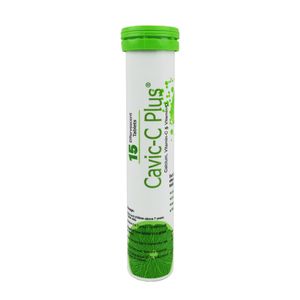Cavic-C Uses, Dosage, Side Effects and more
Calcium is used as a pharmacological agent in humans almost entirely to remedy deficiency. Adequate calcium in the blood is so vital to a wide variety of bodily functions that our internal biochemistry will not tolerate a deficiency even for short periods.
Vitamin-C is an essential component of the diet as man can not synthesize vitamin-C. It is a very powerful reducing agent. Vitamin-C plays an important part in the response of the body to stress. It is important in the defense against infection.

| Attribute | Details |
|---|---|
| Trade Name | Cavic-C |
| Generic | Calcium Lactate Gluconate + Calcium Carbonate + Vitamin-C |
| Weight | 1000mg+327mg+500mg |
| Type | Effervescent Tablet |
| Therapeutic Class | Specific mineral & vitamin combined preparations |
| Manufacturer | Incepta Pharmaceuticals Limited |
| Available Country | Bangladesh |
| Last Updated: | January 7, 2025 at 1:49 am |
Uses
This is used for-
- Increased demand for Calcium and Vitamin-C, e.g. pregnancy, lactation, periods of rapid growth (childhood, adolescence), in old age
- During infectious disease and convalescence
- Treatment of calcium and vitamin-C deficiency
- Osteoporosis
- Premenstrual syndrome
- Postmenopausal problems
- Adjuvant in colds and influenza.
Cavic-C is also used to associated treatment for these conditions: Acid Reflux, Acid indigestion, Bloating, Calcium Deficiency, Calcium Metabolism Disorders, Calcium and Vitamin D Deficiencies, Colic, Dyspepsia, Gastric Ulcer, Gastroesophageal Reflux, Heartburn, Hemorrhoids, Hot Flushes, Hyperacidity, Hyperphosphataemia, Hypovitaminosis D, Low Bone Density, Osteodystrophy, Osteomalacia, Osteoporosis, Postmenopausal Osteoporosis, Postoperative Gas, Proctitis, Vertebral Fractures, Calcium loss, Gastrointestinal ulceration, Dietary supplementationCalcium Deficiency, Hypovitaminosis D, Osteomalacia, Osteoporosis, Calcium supplementation
How Cavic-C works
Calcium carbonate is a basic inorganic salt that acts by neutralizing hydrochloric acid in gastric secretions. It also inhibits the action of pepsin by increasing the pH and via adsorption. Cytoprotective effects may occur through increases in bicarbonate ion (HCO3-) and prostaglandins. Neutralization of hydrochloric acid results in the formation of calcium chloride, carbon dioxide and water. Approximately 90% of calcium chloride is converted to insoluble calcium salts (e.g. calcium carbonate and calcium phosphate).
Dosage
Adults and children above 7 years: 1 effervescent tablet daily
Children 3 to 7 years:½ effervescent tablet daily
Infants: As prescribed by the physician
Dissolve one tablet in half glass (100 ml) of water.
How Long Does It Take to Work?
How Long Does It Take to Work? see here Cavic-C
Side Effects
In rare cases, mild gastrointestinal disturbances (bloating, diarrhoea) can occur. In predisposed patients prolonged treatment with high doses may promote the formation of calculi in the urinary tract.
Precaution
For patients with mild hypercalciuria (exceeding 300 mg = 7.5 mmol/24 hours), with mild or moderate impairment of renal function or with a history of urinary concrements, monitoring of calcium excretion in the urine is required. If necessary, the dosage should be reduced or therapy should be discontinued. High doses of vitamin-D and derivatives should be avoided during treatment with this preparation unless especially indicated.
Since citrate salts have been reported to increase aluminium absorption, this medicine should be used with caution in patients with severely impaired renal function, especially those receiving aluminium-containing preparations. The sugar content should be taken into account by diabetic patients.
Interaction
Calcium Gluconate: Co-admin of high calcium doses with thiazide diuretics may result in milk-alkali syndrome and hypercalcaemia. May potentiate digoxin toxicity. Decreases effects of calcium channel blockers. Enhanced absorption with calcitriol (a vitamin D metabolite).
Calcium Carbonate: Co-administration with thiazide diuretics or vit D may lead to milk-alkali syndrome and hypercalcaemia. Decreased absorption with corticosteroids. Decreases absorption of tetracyclines, atenolol, iron, quinolones, alendronate, Na fluoride, Zn and calcium-channel blockers. Enhances cardiac effects of digitalis glycosides and may precipitate digitalis intoxication.
Vitamin C: Deferroxamine, hormonal contraceptives, flufenazine, warfarin, elemental iron, salicylates, warfarin, fluphenazine, disulfiram, mexiletine, vitamin B12.
Volume of Distribution
Calcium is rapidly distributed taken up by skeletal tissues following absorption and distribution into extracellular fluids. Bone contains 99% of the body's calcium and the remaining 1% is approximately equally distributed between intracellular and extracellular fluids.
Elimination Route
Maximal absorption occurs at doses of 500 mg or less taken with food. Oral bioavailability depends on intestinal pH, the presence of food and dosage.
Elimination Route
Excreted mainly in the feces. The majority of renally filtered calcium is reabsorbed in the ascending limb of the loop of Henle and the proximal and distal convoluted tubules. Also secreted by sweat glands.
Pregnancy & Breastfeeding use
Calcium containing drugs have been widely used in pregnancy by way of oral calcium supplementation or antacid therapy. Calcium Carbonate can be safely used inlactating women. Vitamin-C may be taken safely during pregnancy and lactation
Contraindication
Hypercalcemia (e.g. in hyperparathyroidism, vitamin-D overdosage, decalcifying tumors such as plasmocytoma, bone metastases); severe hypercalciuria; severe renal failure.
Patients with hyperoxalauria, glucose-6- phosphate dehydrogenase deficiency, or iron overload. Larger doses may lead to gastrointestinal tract upset.
Special Warning
USE IN CHILDREN: Calcium carbonate has been extensively studied in children and infants with chronic renal failure and is both safe and effective.
USE IN ELDERLY: In case of elderly patients with renal failure when calcium carbonate is taken constipation may be troublesome one for this group. For this reason, monitoring of serum calcium and phosphate is of course indicated for elderly patients.
Acute Overdose
Acute overdosage has not been reported. It would be expected to cause gastrointestinal disturbances but not to result in hypercalcemia, except in patients treated with a very high dosage of vitamin-D and derivatives.
Storage Condition
Store at a cool and dry place and protected from light and moisture.



